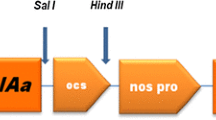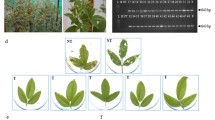Abstract
In an effort to develop a chemically inducible system for insect management, we studied production of Cry1Ab Bacillus thuringiensis (Bt) protein and control of the diamondback moth (DBM), Plutella xylostella L., in inducer-treated and untreated tissues of a broccoli line transformed with a PR-1a/cry1Ab expression cassette. Spraying leaves of these plants with the inducer acibenzolar-S-methyl (= 1,2,3 benzothiadiazole-7-thiocarboxylic acid-S-methyl-ester) (ASM) triggered expression of the cry1Ab gene and produced a high level of Cry1Ab protein within 2–3 days. Cry1Ab protein persisted in leaves for at least 8 weeks, providing prolonged protection from P. xylostella attack. Signals generated in inducer-treated leaves were transferred to untreated newly emerged leaves or heads, as seen by production of Cry1Ab protein and/or protection from insect damage in these plant parts. Signal transduction proceeded in an attenuated manner up to the sixth newly emerged leaf. No Cry1Ab protein was detectable by ELISA in uninduced young leaves, but small amounts of the protein were present in uninduced leaves older than 3 weeks and caused some insect mortality. Such basal expression of Bt genes without induction may favor the evolution of resistant insect populations and therefore limits the application of the PR-1a/cry1Ab system for insect management. However, the rapid production and steady maintenance of a high level of transgenic protein upon induction, the signal transduction observed, and the fact that the chemical inducer can be used in field conditions make the PR-1a promoter attractive for chemical regulation of other agriculturally or pharmaceutically important genes for which low expression in the absence of induction is not a concern.






Similar content being viewed by others
Abbreviations
- ASM:
-
Acibenzolar-S-methyl (=1,2,3 benzothiadiazole-7-thiocarboxylic acid-S-methyl-ester)
- Bt:
-
Bacillus thuringiensis
- DBM:
-
Diamondback moth
- ELISA:
-
Enzyme-linked immunosorbant assay
- PR:
-
Pathogenesis-related
- SA:
-
Salicylic acid
- SAR:
-
Systemic acquired resistance
- TSP:
-
Total soluble protein
References
Abbott WS (1925) A method of computing the effectiveness of an insecticide. J Econ Entomol 18:265
Aoyama T, Chua NH (1997) A glucocorticoid-mediated transcriptional induction system in transgenic plants. Plant J 11:605
Bates SL, Zhao JZ, Roush RT, Shelton AM (2005a) Insect resistance management in genetically engineered crops: past, present and future. Nature Biotechnol 23:57
Bates SL, Cao J, Zhao JZ, Earle ED, Roush RT, Shelton AM (2005b) Evaluation of a chemically-inducible promoter for developing a within-plant refuge for resistance management. J Econ Entomol 98(6):2188–2194
Bio-Rad Laboratories (2005) http://www.bio-rad.com
Caddick MX, Greenland AJ, Jepson I, Krause KP, Qu N, Riddell KV, Salter MG, Schuch W, Sonnewald U, Tomsett AB (1998) An ethanol inducible gene switch for plants used to manipulate carbon metabolism. Nature Biotechnol 16:177
Cao J, Earle ED (2003) Transgene expression in broccoli (Brassica oleracea var. italica) clones propagated in vitro via leaf explants. Plant Cell Rep 21:789
Cao J, Shelton AM, Earle ED (2001) Gene expression and insect resistance in transgenic broccoli containing a Bacillus thuringiensis cry1Ab gene with the chemically inducible PR-1A promoter. Mol Breed 8:207
Cao J, Zhao JZ, Tang JD, Shelton AM, Earle ED (2002) Broccoli plants with pyramided cry1Ac and cry1C genes control diamondback moths resistant to Cry1A and Cry1C proteins. Theor Appl Genet 105:258
Cao J, Shelton AM, Earle ED (2005) Development of transgenic collards (Brassica oleracea L., var. acephala) expressing a cry1Ac or cry1C Bt gene for control of the diamondback moth. Crop Prot 24:804
Deveaux Y, Peaucelle A, Roberts GR, Coen E, Simon R, Mizukami Y, Traas J, Murray JAH, Doonan JH, Laufs P (2003) The ethanol switch: a tool for tissue-specific gene induction during plant development. Plant J 36:918
Farmer EE, Ryan CA (1992) Octadecanoid precursors of jasmonic acid activate the synthesis of wound-inducible proteinase inhibitors. Plant Cell 4:129
Friedrich L, Lawton K, Ruess W, Masner P, Specker N, Rella MG, Meier B, Dincher S, Staub T, Uknes S, Métraux JP, Kessmann H, Ryals J (1996) A benzothiadiazole derivative induces systemic acquired resistance in tobacco. Plant J 10:61
Gatz C (1997) Chemical control of gene expression. Annu Rev Plant Physiol Plant Mol Bio 48:89
Gatz C, Frohberg C, Wendenburg R (1992) Stringent repression and homogeneous de-repression by tetracycline of a modified CaMV 35S promoter in intact transgenic tobacco plants. Plant J 2:397
Guo HS, Fei JF, Chua NH (2003) A chemical-regulated inducible RNAi system in plants. Plant J 34:383
Jepson I, Martinez A, Sweetman JP (1998) Chemical-inducible gene expression systems for plants—a review. Pestic Sci 54:360
Koo JC, Asurmendi S, Bick J, Woodford-Thomas T, Beachy RN (2004) Ecdysone agonist-inducible expression of a coat protein gene from tobacco mosaic virus confers viral resistance in transgenic Arabidopsis. Plant J 37:439–448
Martinez A, Jepson I (1999) Ecdysteroid agonist-inducible control of gene expression in plants. In: Reynolds PHS (ed), Inducible gene expression in plants. CABI Publishing, New York, pp 23–41
Malamy J, Klessig DF (1992) Salicylic acid and plant disease resistance. Plant J 2:643
Martinez A, Sparks C, Hart CA, Thompson J, Jepson I (1999) Ecdysone agonist inducible transcription in transgenic tobacco plants. Plant J 19:97
Padidam M (2003) Chemically mediated gene expression in plants. Curr Opin Plant Biol 6:169
Padidam M, Gore M, Lu DL, Smirnova O (2003) Chemical-inducible, ecdysone receptor-based gene expression system for plants. Transgenic Res 12:101–109
Rasmussen JB, Hammerschmidt R, Zook MN (1991) Systemic induction of salicylic acid accumulation in cucumber after inoculation with Pseudomonas syringae pv. syringae. Plant Physiol 97:1342
Reynolds PHS (1999) Inducible gene expression in plants. CABI Publishing, New York
Roush RT (1997) Managing resistance to transgenic crops. In: Carozzi N (ed) Advances in insect control: the role of transgenic plants. Taylor and Francis, London, pp 271–294
Shelton AM, Cooley RJ, Kroening MK, Wilsey WT, Eigenbrode SD (1991) Comparative analysis of two rearing procedures for diamondback moth. J Entomol Sci 26:17
Shelton AM, Zhao JZ, Roush RT (2002) Economic, ecological, food safety and social consequences of the deployment of Bt transgenic plants. Annu Rev Entomol 47:845
Syngenta Crop Protection (2005) http://www.syngentacropprotection-us.com/prod/fungicide/actigard/
Sweetam JP, Chu CC, Qu N, Greenland AJ, Sonnewald U, Jepson I (2002) Ethanol vapor is an efficient inducer of the alc gene expression system in model and crop plant species. Plant Physiol 129:943
Vernooij B, Friedrich L, Morse A, Reist R, Kolditz-jawhar R, Ward E, Uknes S, Kessmann H, Ryals J (1994) Salicylic acid is not the translocated signal responsible for inducing systemic acquired resistance but is required in signal transduction. Plant Cell 6:959
Ward ER, Uknes SJ, Williams SC, Dincher SS, Wiederhold DL, Alexander DC, Ahi-Goy P, Métraux JP, Ryals J (1991) Coordinate gene activity in response to agents that induce systemic acquired resistance. Plant Cell 3:1085
Williams S, Friedrich L, Negrotto D, Carozzi M, Kessmann H, Ward E, Ryals J (1992) Chemical regulation of Bacillus thuringiensis δ-endotoxin expression in transgenic plants. Biotechnology 10:540
Zhao JZ, Li YX, Collins HL, Shelton AM (2002) Examination of the F2 screen for rare resistance alleles to Bacillus thuringiensis toxins in the diamondback moth (Lepidoptera: Plutellidae). J Econ Entomol 95:14–21
Zuo JR, Chua NH (2000) Chemical-inducible systems for regulated expression of plant genes. Curr Opin Biotech 11:146
Acknowledgements
The project was supported by the National Research Initiative of the USDA Cooperative State Research, Education and Extension Service (CSREES), grant number 2002-35302-12502. We thank Ciba-Geigy (Crop Protection Division) for providing the Actigard 50WG™ used in this work
Author information
Authors and Affiliations
Corresponding author
Additional information
Communicated by S. Gleddie
Rights and permissions
About this article
Cite this article
Cao, J., Bates, S.L., Zhao, JZ. et al. Bacillus thuringiensis protein production, signal transduction, and insect control in chemically inducible PR-1a/cry1Ab broccoli plants. Plant Cell Rep 25, 554–560 (2006). https://doi.org/10.1007/s00299-005-0091-4
Received:
Revised:
Accepted:
Published:
Issue Date:
DOI: https://doi.org/10.1007/s00299-005-0091-4




